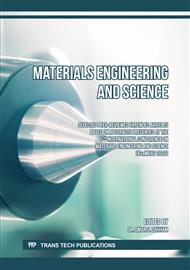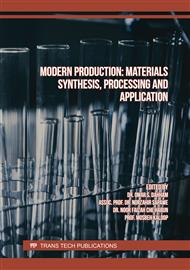[1]
M. Ravindar Reddy, A.R. Subrahmanyam, M. Maheshwar Reddy, J. Siva Kumar, V. Kamalaker, M. Jaipal Reddy, X-RD, SEM, FT-IR, DSC Studies of Polymer Blend Films of PMMA and PEO, Mater. Today 3(10, Part B) (2016) 3713-3718.
DOI: 10.1016/j.matpr.2016.11.018
Google Scholar
[2]
J.d.S. Reinaldo, M.C.B.C.d. Nascimento, E.N. Ito, E. Hage Junior, Rheological, mechanical and morphological properties of poly (methyl methacrylate)/poly (ethylene terephthalate) blend with dual reactive interfacial compatibilization, Polímeros 25(5) (2015) 451-460.
DOI: 10.1590/0104-1428.1924
Google Scholar
[3]
A.M. Abdelghany, E.M. Abdelrazek, A. ElShahawy, A.A. Al-Muntaser, FTIR and UV/Vis. Spectroscopy: a key for miscibility investigation of PVC/PMMA polymer blend, Middle East J Appl Sci 5(5) (2015) 36-44.
Google Scholar
[4]
J. Parameswaranpillai, S. Thomas, Y. Grohens, Polymer Blends: State of the Art, New Challenges, and Opportunities, Characterization of Polymer Blends, 2014, pp.1-6.
DOI: 10.1002/9783527645602.ch01
Google Scholar
[5]
M. Dixit, V. Mathur, S. Gupta, M. Baboo, K. Sharma, N.S. Saxena, Morphology, miscibility and mechanical properties of PMMA/PC blends, Phase Transit. 82(12) (2009) 866-878.
DOI: 10.1080/01411590903478304
Google Scholar
[6]
Z. Sun, W. Wang, Z. Feng, Criterion of polymer-polymer miscibility determined by viscometry, Eur. Polym. J. 28(10) (1992) 1259-1261.
DOI: 10.1016/0014-3057(92)90215-n
Google Scholar
[7]
M. Song, F. Long, Miscibility in blends of poly(vinyl acetate) with poly(methyl methacrylate) studied by FTIR and DSC, Eur. Polym. J. 27(9) (1991) 983-986.
DOI: 10.1016/0014-3057(91)90045-p
Google Scholar
[8]
R. Paladhi, R.P. Singh, Miscibility and interaction studies on some aqueous polymer blend solutions by ultrasonic and rheological techniques, J. Appl. Polym. Sci. 51(9) (1994) 1559-1565.
DOI: 10.1002/app.1994.070510905
Google Scholar
[9]
A.V. Rajulu, R.L. Reddy, S.M. Raghavendra, S.A. Ahmed, Miscibility of PVC/PMMA blend by the ultrasonic and refractive index method, Eur. Polym. J. 35(6) (1999) 1183-1186.
DOI: 10.1016/s0014-3057(98)00078-0
Google Scholar
[10]
P. Saxena, P. Shukla, M.S. Gaur, Thermal analysis of polymer blends and double layer by DSC, Polym. Polym. Compos. 29(9_suppl) (2021) S11-S18.
DOI: 10.1177/0967391120984606
Google Scholar
[11]
K. Aouachria, N. Belhaneche-Bensemra, Miscibility of PVC/PMMA blends by vicat softening temperature, viscometry, DSC and FTIR analysis, Polym. Test. 25(8) (2006) 1101-1108.
DOI: 10.1016/j.polymertesting.2006.07.007
Google Scholar
[12]
N.S. Akpan, U. Idio, S. Usman, A. Idowu, M. Ugbaja, L. Zango, Compatibility Study of Polystyrene and Poly Methyl-methacrylate Blends using FTIR and Viscometry Methods, Commun. Phys. Sci. 4(2) (2019) 81-86.
Google Scholar
[13]
M.A.H. Alzuhairi, A.M. Al-Ghaban, S.N. Almutalabi, Chemical recycling of polyethylene terephthalate (PET) as additive for asphalt, ZANCO J. Pure and Appl. Sci. 28(2) (2016) 675-679.
DOI: 10.1051/matecconf/201816201042
Google Scholar
[14]
Z.A. Hussein, Z.M. Shakor, M. Alzuhairi, F. Al-Sheikh, Thermal and catalytic cracking of plastic waste: a review, Int. J. Environ. Anal. Chem. (2021) 1-18.
DOI: 10.1080/03067319.2021.1946527
Google Scholar
[15]
M.A.A. Alzuhairi, B.I. Khalil, R.S. Hadi, Nano MgO catalyst for chemical depolymerization of polyethylene terephthalate (PET), Iq J. Phys. 16(36) (2018) 85-93.
DOI: 10.30723/ijp.v16i36.33
Google Scholar
[16]
A.M. Hameed, M. Alzuhairi, S.I. Ibrahim, Studying some of mechanical properties and microstructure analysis for cement mortar using waste of depolymerized Polyethylene terephthalate by using bubble column technique, IOP Conference Series: Earth and Environmental Science 779(1) (2021) 012097.
DOI: 10.1088/1755-1315/779/1/012097
Google Scholar
[17]
S.I. Salih, J.K. Oleiwi, H.M. Ali, Development the Physical Properties of Polymeric Blend (SR/ PMMA) by Adding various Types of Nanoparticles, Used for Maxillofacial Prosthesis Applications, Eng. Technol. 37(4A) (2019) 120-127.
DOI: 10.30684/etj.37.4a.2
Google Scholar
[18]
ASTM_D3418-2, Standard test method for transition temperatures of polymers by differential scanning calorimetry, ASTM International (1999).
Google Scholar
[19]
M. Alzuhairi, H. Al-Kaisy, M. Khdheer, Depolymerization of Waste Plastic Using Bubble Column for Nano Alumina Blended Coating, Fluids 7(4) (2022) 127.
DOI: 10.3390/fluids7040127
Google Scholar
[20]
G. Zhang, J. Zhang, S. Wang, D. Shen, Miscibility and phase structure of binary blends of polylactide and poly(methyl methacrylate), J Polym Sci B Polym Phys 41(1) (2003) 23-30.
DOI: 10.1002/polb.10353
Google Scholar
[21]
M. Ramesan, G. Kalaprasad, In situ synthesis of poly (methyl methacrylate)/cobalt II nitrate: Structural, thermal and electrical conductivity, J. Chem. Pharm. 7(11) (2015) 326-331.
Google Scholar



